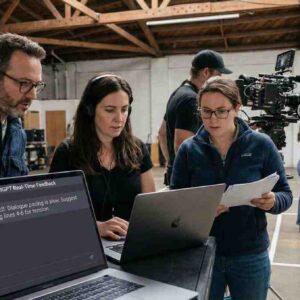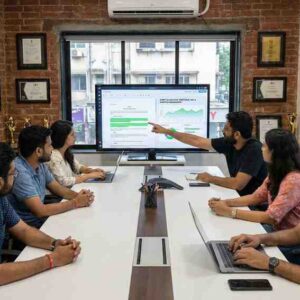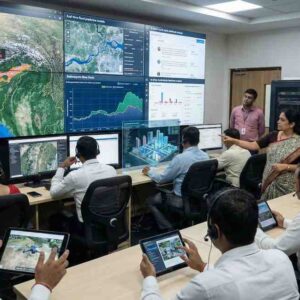Intelligent Roads: How AI is Revolutionizing Traffic Management in Indian Cities
Highlights at a Glance:
- AI-driven traffic management systems are helping Indian cities combat congestion, reduce travel time, and improve road safety for commuters.
- Real-time traffic data, predictive analytics, and smart signaling powered by AI are transforming the way cities manage traffic flow.
- As urban populations grow and car ownership increases, AI is becoming a vital tool in ensuring smoother, safer, and more efficient commutes.
By the Numbers:
- AI-based traffic management systems have reduced average traffic congestion by 30% in cities like Bengaluru and Delhi, according to a 2023 report by the Ministry of Urban Affairs.
- Real-time data analysis and AI optimizations have decreased average commute times by 20%, according to a study by the Indian Institute of Technology (IIT) Delhi.
- 40% of Indian commuters report improved traffic flow and reduced congestion in areas where AI-driven systems have been implemented.
AI: A New Era for Traffic Management in India
With India’s urban population rapidly expanding and the number of vehicles on the road increasing, AI has emerged as a game-changer in managing traffic congestion. By using real-time data, predictive models, and smart technologies, AI solutions are helping Indian cities create safer and more efficient transportation networks for commuters.
Real-Time Traffic Data Collection and Analysis
AI systems are enhancing traffic monitoring and data collection:
- Smart Sensors and Cameras: AI-powered cameras and sensors capture real-time traffic data, including vehicle count, speed, and congestion levels. This data is used to dynamically adjust traffic signals and road usage patterns.
- Data-Driven Insights: AI analyzes this data to identify traffic patterns, peak congestion times, and accident hotspots, providing city authorities with actionable insights to optimize traffic flow.
These systems enable more proactive management of traffic, allowing for adjustments to be made on the fly based on actual road conditions.
Predictive Traffic Management
AI’s predictive capabilities are reshaping traffic control:
- Traffic Flow Forecasting: AI tools use historical traffic data combined with real-time information to predict future congestion, helping to plan and divert traffic to alternative routes before problems arise.
- Optimized Signal Timing: AI adjusts traffic signal timings in real-time based on current traffic conditions, allowing for smoother traffic flow and reducing waiting times at intersections.
By anticipating traffic conditions, AI allows authorities to prevent bottlenecks and reduce congestion before it escalates.
Intelligent Parking Solutions
AI is also improving parking efficiency in crowded urban areas:
- Smart Parking Systems: AI-driven systems help identify available parking spaces by analyzing data from sensors in parking lots and garages. These systems direct drivers to the nearest available spot, reducing time spent searching for parking and minimizing congestion in busy areas.
- Dynamic Parking Pricing: AI can adjust parking prices based on demand, encouraging drivers to park in underutilized areas and reducing traffic around high-demand zones.
This approach maximizes parking space utilization and reduces traffic caused by people circling to find a spot.
AI in Public Transport Coordination
AI enhances the efficiency of public transport systems:
- Bus and Metro Scheduling: AI uses real-time data from buses, metro trains, and other forms of public transport to optimize schedules, reduce waiting times, and provide more efficient services to commuters.
- Passenger Demand Prediction: AI models predict when and where passengers are likely to board or alight, enabling public transport systems to adjust capacity accordingly and reduce overcrowding.
These AI applications improve the efficiency of public transport, offering commuters a more convenient and reliable alternative to private vehicles.
Challenges and Considerations
While AI offers immense benefits, the implementation of these systems in Indian cities faces challenges:
- Infrastructure Gaps: Not all cities have the necessary infrastructure to support AI-driven traffic management solutions, especially in smaller or developing regions.
- Data Privacy and Security: The extensive data collected by AI-powered systems raises concerns about data privacy and security. Ensuring proper safeguards are in place is crucial.
- Interoperability: Integrating AI systems with existing traffic management infrastructure can be complex, requiring significant upgrades and collaboration between government agencies and private tech providers.
Addressing these challenges requires investment in infrastructure, regulatory frameworks, and technical expertise.
The Future of AI in Traffic Management in India
Looking forward, AI is poised to revolutionize how Indian cities manage traffic:
- Integrated Smart City Systems: AI will become an integral part of smart city initiatives, where traffic management, public transport, waste management, and other urban services are interconnected for more efficient governance.
- Autonomous Vehicles: As AI continues to evolve, the integration of autonomous vehicles into Indian cities could further optimize traffic flow and reduce accidents caused by human error.
- AI-Enabled Multimodal Transportation Networks: AI will help seamlessly connect various modes of transport (e.g., cars, buses, metro) to create more efficient, multimodal transportation networks that offer greater flexibility and convenience for commuters.
By 2030, AI is expected to be a cornerstone of urban mobility strategies in India, ensuring that traffic systems are more adaptive, efficient, and sustainable.
AI’s integration into traffic management in India is already improving the daily commute for millions of people. By harnessing the power of real-time data and predictive analytics, Indian cities are becoming smarter, more efficient, and better equipped to handle the challenges of rapid urbanization. As AI continues to advance, its potential to reshape urban transportation will only grow, driving the development of safer, more sustainable cities.













